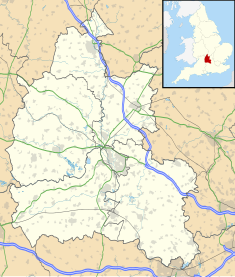Cornhill Corn Exchange, Banbury
| Cornhill Corn Exchange, Banbury | |
|---|---|
 Cornhill Corn Exchange, Banbury | |
| Location | Market Place, Banbury |
| Coordinates | 52°03′45″N 1°20′09″W / 52.0626°N 1.3359°W |
| Built | 1857 |
| Architect | William Hill |
| Architectural style(s) | Neoclassical style |
Listed Building – Grade II | |
| Official name | Façade, Cornhill Corn Exchange, Castle Centre |
| Designated | 7 October 1969 |
| Reference no. | 1046917 |
The Cornhill Corn Exchange was a commercial building in the Market Place, Banbury, Oxfordshire, England. The façade of the building, which has been preserved and now forms an entrance to a shopping centre, is a Grade II listed building.[1]
History[edit]
In the early-1850s, a group of local businessmen decided to form a private company, known as the "Banbury Corn Exchange Company", to finance and commission a corn exchange for the town.[2] The site they selected was in the northeast corner of the Market Place in an area known as "Cornhill".[3] The group received political support from the Conservative councillors and their building was financed by Gilletts Bank.[4]
The new building was designed by William Hill of Leeds, built by Messrs Kimberly of Banbury in ashlar stone and was officially opened on 3 September 1857.[5] The design involved a symmetrical main frontage of five bays facing onto the Market Place. The central section of the three bays featured tall round headed openings with architraves and keystones on the ground floor, and small round headed windows with architraves on the first floor. The outer bays contained blind round headed windows on both floors. The bays of the central section were flanked by pairs of Corinthian order columns supporting a frieze, an entablature and a pediment. There was a quatrefoil surmounted by a ram's head as well as fruit and foliage in the tympanum, and, at the apex of the pediment, there was a statue of the Roman goddess of agriculture, Ceres.[6] The elaborate stone carving was undertaken by Thorpe and Ponder.[7] The architectural historian, Nikolaus Pevsner, criticised the design describing it as "a pompous classical palace".[8]
The Cornhill Corn Exchange got into financial difficulty after suffering substantial competition from a rival group of businessmen which formed the "Central Corn Exchange for Banbury Company": this group had political support from Liberal councillors and their building was financed by Cobbs Bank: it was erected on a site in the southwest corner of the Market Place and opened it on the same day as the Cornhill Corn Exchange.[4][a]
The use of the building as a corn exchange declined significantly in the wake of the Great Depression of British Agriculture in the late 19th century.[10] Instead, it was converted into a public house known as the Vine Tavern in 1891. Most of the building was demolished in 1973 leaving the façade to become the entrance to the new Castle Quay Shopping Centre.[11]
See also[edit]
Notes[edit]
- ^ The Central Corn Exchange was given a new Renaissance style façade in around 1880, converted into the Palace Cinema in 1914, and re-purposed as a toy shop in 1961. It was demolished in 1979 and replaced by a branch of Midland Bank, with a main frontage designed in a similar style to the 1880 façade.[9]
References[edit]
- ^ Historic England. "Façade, Cornhill Corn Exchange, Castle Centre (1046917)". National Heritage List for England. Retrieved 15 May 2023.
- ^ "Banbury Corn Exchange Company Ltd. Registered between 1844 and 1856". National Archives. Retrieved 15 May 2023.
- ^ Colvin, Christina; Cooper, Janet; Cooper, N. H.; Harvey, P. D. A.; Hollings, Marjory; Hook, Judith; Jessup, Mary; Lobel, Mary D.; Mason, J. F. A.; Trinder, B. S.; Turner, Hilary (1972). "'Banbury: Origins and growth of the town', in A History of the County of Oxford: Volume 10, Banbury Hundred, ed. Alan Crossley". London: British History Online. pp. 18–28. Retrieved 15 May 2023.
- ^ a b Tancred, Henry William (1969). A Victorian M.P. and His Constituents The Correspondence of H. W. Tancred, 1841–1859. Banbury Historical Society.
- ^ Jenkins, Stanley C. (2013). North Oxfordshire Cotswolds Through Time Adderbury, Banbury, Bloxham, Chipping Norton, Deddington, Hook Norton & Wroxton. Amberley Publishing. ISBN 978-1445613024.
- ^ Building News, iii (1857), 902. See plate facing p. 30.
- ^ Builder, xv (1857), 152.
- ^ Sherwood, Jennifer; Pevsner, Nikolaus (1974). Oxfordshire (Buildings of England Series). Yale University Press. p. 439. ISBN 978-0300096392.
- ^ "Palace Cinema". Cinema Treasures. Retrieved 15 May 2023.
- ^ Fletcher, T. W. (1973). 'The Great Depression of English Agriculture 1873-1896' in British Agriculture 1875-1914. London: Methuen. p. 31. ISBN 978-1136581182.
- ^ "Cake and Cockhorse" (PDF). Banbury Historical Society. 2021. p. 78. ISSN 0522-0823.

